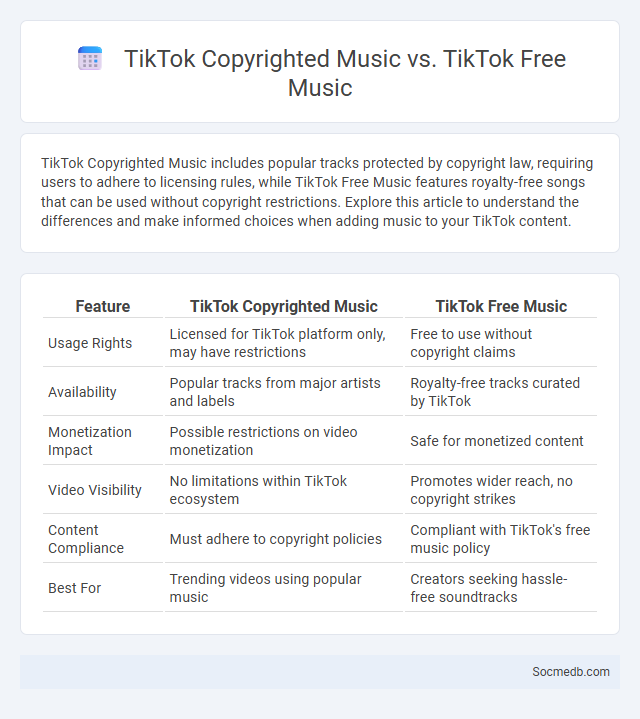
Photo illustration: TikTok Copyrighted Music vs TikTok Free Music
TikTok Copyrighted Music includes popular tracks protected by copyright law, requiring users to adhere to licensing rules, while TikTok Free Music features royalty-free songs that can be used without copyright restrictions. Explore this article to understand the differences and make informed choices when adding music to your TikTok content.
Table of Comparison
| Feature | TikTok Copyrighted Music | TikTok Free Music |
|---|---|---|
| Usage Rights | Licensed for TikTok platform only, may have restrictions | Free to use without copyright claims |
| Availability | Popular tracks from major artists and labels | Royalty-free tracks curated by TikTok |
| Monetization Impact | Possible restrictions on video monetization | Safe for monetized content |
| Video Visibility | No limitations within TikTok ecosystem | Promotes wider reach, no copyright strikes |
| Content Compliance | Must adhere to copyright policies | Compliant with TikTok's free music policy |
| Best For | Trending videos using popular music | Creators seeking hassle-free soundtracks |
Understanding TikTok Copyrighted Music
TikTok's algorithm enforces strict copyright rules to protect original music creators, requiring users to leverage licensed tracks available in its music library. Content creators often face takedown notices or muted audio when using unlicensed copyrighted songs, impacting video engagement and reach. Navigating TikTok's copyright policies ensures legal compliance and maximizes creative freedom within the platform's community guidelines.
Exploring TikTok’s Free Music Library
TikTok's Free Music Library offers a vast collection of royalty-free tracks and sound effects designed to enhance your videos without copyright concerns. You can browse and select from diverse genres, moods, and themes, ensuring the perfect soundtrack for your content. Utilizing this library optimizes engagement and creativity while protecting your social media presence legally.
What Is Sound Copyright?
Sound copyright protects original audio creations, including music, sound recordings, and audio effects, ensuring creators have exclusive rights to distribute, reproduce, and perform their work. Social media platforms implement copyright detection tools, such as Content ID on YouTube, to identify unauthorized use of copyrighted sounds and enforce removal or monetization policies. Understanding sound copyright is crucial for content creators to avoid infringement claims and maintain legal control over their audio assets on social channels.
Differences Between Copyrighted and Free Music on TikTok
TikTok's platform differentiates copyrighted music, which requires licensing agreements and may restrict usage, from free music available in its built-in library that users can freely incorporate into their videos without legal concerns. Copyrighted tracks carry limitations such as regional restrictions, potential muting, or takedown of videos, while free music is curated for unrestricted use, ensuring compliance with platform policies. Understanding these distinctions is crucial for creators aiming to avoid copyright claims and maintain video visibility on TikTok.
Risks of Using Copyrighted Songs on TikTok
Using copyrighted songs on TikTok without proper authorization can lead to account suspensions, removal of content, or legal actions due to copyright infringement. TikTok's automated content identification systems detect unauthorized music use, resulting in muted videos or takedown notices. Creators face financial penalties and damage to reputation if copyright holders pursue claims, emphasizing the importance of licensing or using royalty-free tracks.
How to Identify Copyright-Free Music on TikTok
Identifying copyright-free music on TikTok involves using the platform's built-in music library labeled as "Sounds" or "TikTok Commercial Music Library," which offers tracks cleared for user-generated content. Look for audio clips marked with licenses allowing free use, especially those under TikTok's royalty-free collections or original creator sounds explicitly tagged for reuse. Avoid uploading or using trending songs from popular artists without verification, as these are often protected by copyright and may lead to content removal or account strikes.
Legal Consequences of Copyright Infringement on TikTok
TikTok users face significant legal consequences for copyright infringement, including potential lawsuits, fines, and account suspension. Unauthorized use of copyrighted music, videos, or images can trigger takedown notices under the Digital Millennium Copyright Act (DMCA). Protect your content by obtaining proper licenses or using royalty-free materials to avoid legal penalties and safeguard Your presence on the platform.
Tips for Using Music Safely on TikTok
Using music safely on TikTok requires selecting tracks from TikTok's licensed library to avoid copyright violations and potential account strikes. Users should review TikTok's copyright policies regularly and consider using royalty-free music or original sounds to maintain compliance. Proper attribution for external music sources ensures respect for creators' rights and minimizes legal risks.
Alternatives to TikTok’s Built-in Music Options
Alternatives to TikTok's built-in music options include royalty-free music libraries like Epidemic Sound, Artlist, and Soundstripe, which offer extensive catalogs tailored for content creators. Platforms such as YouTube Audio Library and Free Music Archive provide free tracks with various licensing options suitable for TikTok videos, enhancing originality and compliance. Independent artists on Bandcamp and SoundCloud also present unique music choices, allowing creators to support emerging talent while diversifying their audio content.
Best Practices for Original Sound Creation on TikTok
Creating original sounds on TikTok involves focusing on clear audio quality and catchy, relatable content that resonates with target audiences. Utilizing trending audio structures while incorporating unique elements helps in boosting virality and user engagement. Consistently analyzing analytics for sound performance enables creators to refine their approach and maximize reach within the TikTok algorithm.
 socmedb.com
socmedb.com